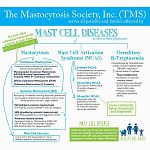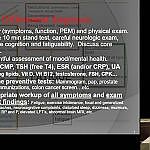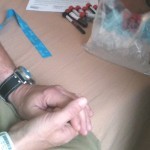Remy
Administrator
I'm going to move this abstract from the original thread here because I would like very much for someone more knowledgeable to comment on whether or not those CPET improvements are anything to be impressed by or not...
"during exercise while on K-strophanthin, peak oxygen consumption was augmented by 1.4 ml/min/kg (p < 0.01) and oxygen consumption at anaerobic threshold by 2.2 ml/min/kg (p < 0.01);"
Clin Cardiol. 1994 Oct;17(10):536-41.
"during exercise while on K-strophanthin, peak oxygen consumption was augmented by 1.4 ml/min/kg (p < 0.01) and oxygen consumption at anaerobic threshold by 2.2 ml/min/kg (p < 0.01);"
Clin Cardiol. 1994 Oct;17(10):536-41.
Long-term use of K-strophanthin in advanced congestive heart failure due to dilated cardiomyopathy: a double-blind crossover evaluation versus digoxin.
Agostoni PG1, Doria E, Berti M, Guazzi MD
Abstract
K-strophanthin or digoxin were added to diuretics (all cases) and vasodilators (most cases) for treating advanced congestive heart failure in 22 patients with dilated cardiomyopathy and sinus rhythm. K-strophanthin (0.125 mg intravenously) or digoxin (0.25 mg orally) were administered daily in two 3-month periods, during which vasodilators and diuretics were kept constant and patients received one of the two digitalis preparations in a double-blind fashion, crossing over to the alternative preparation in the next period. Blindness was assured throughout the trial with a daily intravenous injection of 10 ml normal saline solution either containing K-strophanthin or not, and with daily oral administration of either placebo or active digoxin.
At the end of the run-in period, 15 days after starting active preparations, and thereafter every month for the next 6 months, we evaluated left ventricular pump function at rest and patients' functional performance by a cardiopulmonary exercise test.
At Day 15, cardiac index and ejection fraction at rest, compared with run-in, were significantly raised with both glycosides; during exercise while on K-strophanthin, peak oxygen consumption was augmented by 1.4 ml/min/kg (p < 0.01) and oxygen consumption at anaerobic threshold by 2.2 ml/min/kg (p < 0.01); corresponding variations on digoxin (-0.1 and +0.3, respectively) were not significant versus run-in. These patterns were duplicated at repeated tests during follow-up.(ABSTRACT TRUNCATED AT 250 WORDS)
PMID:
8001300
[PubMed - indexed for MEDLINE]
Free full text
Agostoni PG1, Doria E, Berti M, Guazzi MD
Abstract
K-strophanthin or digoxin were added to diuretics (all cases) and vasodilators (most cases) for treating advanced congestive heart failure in 22 patients with dilated cardiomyopathy and sinus rhythm. K-strophanthin (0.125 mg intravenously) or digoxin (0.25 mg orally) were administered daily in two 3-month periods, during which vasodilators and diuretics were kept constant and patients received one of the two digitalis preparations in a double-blind fashion, crossing over to the alternative preparation in the next period. Blindness was assured throughout the trial with a daily intravenous injection of 10 ml normal saline solution either containing K-strophanthin or not, and with daily oral administration of either placebo or active digoxin.
At the end of the run-in period, 15 days after starting active preparations, and thereafter every month for the next 6 months, we evaluated left ventricular pump function at rest and patients' functional performance by a cardiopulmonary exercise test.
At Day 15, cardiac index and ejection fraction at rest, compared with run-in, were significantly raised with both glycosides; during exercise while on K-strophanthin, peak oxygen consumption was augmented by 1.4 ml/min/kg (p < 0.01) and oxygen consumption at anaerobic threshold by 2.2 ml/min/kg (p < 0.01); corresponding variations on digoxin (-0.1 and +0.3, respectively) were not significant versus run-in. These patterns were duplicated at repeated tests during follow-up.(ABSTRACT TRUNCATED AT 250 WORDS)
PMID:
8001300
[PubMed - indexed for MEDLINE]
Free full text












